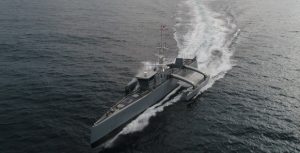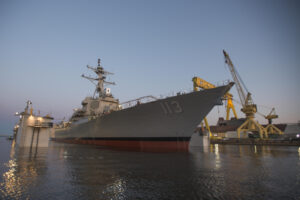Navy Wary of Growing Costs While It Ramps Up Ops
Posted on

Harry S. Truman Carrier Strike Group in the Atlantic Ocean, April 2019.
WASHINGTON: The Navy’s upcoming force structure assessment won’t back away from the service’s long-time goal of a 355-ship fleet, a top official said Wednesday, suggesting that the number may actually inch higher. But the service is also getting some sobering feedback on how much it will cost to sustain a significantly larger fleet — something it hasn’t had to do in decades.
As the Navy plans for more ships, Vice Adm. William Merz Deputy Chief Of Naval Operations For Warfare Systems said Wednesday, “we’re also coming to realize what that is going to cost, and how you’re going to sustain today’s fleet while continuing to grow.” The planning process is “much more challenging than anyone realized,” he said, “but we’re much smarter about our business” than just a few years ago.
The much-anticipated Force Structure Assessment, which CNO Adm. John Richardson has said should be released this summer, is expected to lay out the kinds of capabilities the Navy wants in the near-term to meet and deter potential adversaries like China and Russia.
But taking the fleet from under 300 ships to at least 355 is a daunting task, Merz said at the Center for Strategic and International Studies. “We don’t have the complex modeling to even understand what all of these costs are going to materialize to over the next 20 years,” he said, but the service is “working hard to converge on a model” to sustain the ships over the long haul.
The last assessment came in 2016, well before the Navy began investing heavily in unmanned ships — a new commitment the Navy wants to spend $3.7 billion exploring in the 2020 budget request. As part of that, the service asked for $447 million in 2020 for two Large Unmanned Surface Vessels which it plans to get into the water quickly.
After 2020, the Navy plans to buy two LUSVs a year until 2024, for a total of about $2.7 billion as part of a larger effort to buy 232 unmanned platforms of different sizes and configurations over the next several years.

The Sea Hunter, an experimental unmanned submarine-hunter.
Adding more unmanned vessels to the fleet has raised a novel question that naval officers in previous generations have not had to grapple with: if the boat isn’t crewed by humans, should it count as a ship?
Merz said it’s not an issue at this point. “I don’t really care how we count them. To me, it’s all about naval capability and effective naval power. The only point where I get concerned is when you talk about replacing battle force ships with unproven” vessels.
The question of how those ships are counted toward the Navy end strength is critical to the Navy’s plans for the future, however, and important to Congress, which allocates the money for ship building, maintenance, and overall readiness.
Merz added that the two elements the Navy is most concerned about as they build new unmanned vessels are practicality, and technology. “We’re all in on the technology; the practicality of them we’re just going to have to live through. We have to get these things into the fleet, and we have to get them into the fleet in a hurry.” In the end, “we’re all in. We’re pouring as much money into these systems as we think industry can handle.”
Overall, moving some missions to unmanned platforms is “decomposing the capabilities that are resident in large, monolithic, multi-mission platforms” like destroyers, carriers, or submarines, Bryan Clark, an analyst at the Center for Strategic and Budgetary Assessments, said at an event last month. “That approach has stood the test of time in naval warfare, but it may not be the approach we need to take going forward.”
Instead of one destroyer, “it’s a frigate and two unmanned surface vessels — that fleet might offer the opportunity to break this linkage between the number of ships, number of people, and certain sustainment costs because those unmanned vehicles will take less people — or no people” and will likely be less expensive to maintain.
Keeping the fleet fit
Potentially hundreds of unmanned boats are coming as the Navy is struggling to maintain the fleet it currently has, with submarines waiting for weeks or months to enter dock for refit and 70 percent of destroyers overstay their maintenance availabilities.

Launch of the destroyer USS Finn (DDG 113)
Adding to the stresses on the fleet is the new Dynamic Force Employment model, which aims to move ships around on unpredictable schedules, disrupting carefully planned pier-side repair schedules.
Merz said the force assessment will assume this way of doing business has become a permanent state of affairs, and plan the fleet accordingly.
Dynamic Force Employment is “not a discrete event, it’s a lifestyle, and it’s a lifestyle in the world of great power competition,” he said. “It does dictate different capabilities that we need, and it will be central to this force structure assessment that comes out. You will probably see an emphasis on speed, agility, adaptability — do we have the mix of the ships correct to support dynamic force employment? Do we have the right logistics train? We’re very optimized for peacetime logistics, how does that look as you go through the phases of escalation if we’re ever faced with that?”
The assessment will try to take all of this into account, which is no easy task. The Navy is planning new classes of frigates, unmanned boats, and potentially a cruiser coming on line in the near future, presenting new supply chains to manage.
The new plan “really focuses on the Navy you have, the Navy you have on the record to buy, and then it compares that to the demands of the [combatant commanders], and it forms an opinion of how many of these ships you need to meet those demands.”
The end result will blend estimates that account for “some risk, some attrition, and then you add up all the numbers.” Right now that number is 355, and while “we certainly don’t see that number going down, it is going to be more reflective” of the dynamic force employment construct than in the past.
Subscribe to our newsletter
Promotions, new products and sales. Directly to your inbox.
